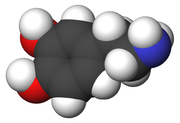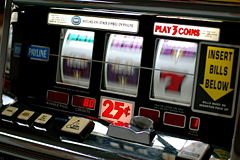
Dopamine dysregulation syndrome
Encyclopedia

Reward system
In neuroscience, the reward system is a collection of brain structures which attempts to regulate and control behavior by inducing pleasurable effects...
in subjects with Parkinson's disease
Parkinson's disease
Parkinson's disease is a degenerative disorder of the central nervous system...
(PD) due to a long exposure to dopamine
Dopamine
Dopamine is a catecholamine neurotransmitter present in a wide variety of animals, including both vertebrates and invertebrates. In the brain, this substituted phenethylamine functions as a neurotransmitter, activating the five known types of dopamine receptors—D1, D2, D3, D4, and D5—and their...
replacement therapy (DRT). It is characterized by self-control problems such as addiction to medication, gambling, or hypersexuality
Hypersexuality
Hypersexuality is extremely frequent or suddenly increased sexual urges or sexual activity. Hypersexuality is typically associated with lowered sexual inhibitions. Although hypersexuality can be caused by some medical conditions or medications, in most cases the cause is unknown...
.
Causes
Parkinson's disease is a common neurological disorderNeurology
Neurology is a medical specialty dealing with disorders of the nervous system. Specifically, it deals with the diagnosis and treatment of all categories of disease involving the central, peripheral, and autonomic nervous systems, including their coverings, blood vessels, and all effector tissue,...
characterized by a degeneration of dopamine neuron
Neuron
A neuron is an electrically excitable cell that processes and transmits information by electrical and chemical signaling. Chemical signaling occurs via synapses, specialized connections with other cells. Neurons connect to each other to form networks. Neurons are the core components of the nervous...
s in the substantia nigra
Substantia nigra
The substantia nigra is a brain structure located in the mesencephalon that plays an important role in reward, addiction, and movement. Substantia nigra is Latin for "black substance", as parts of the substantia nigra appear darker than neighboring areas due to high levels of melanin in...
and a loss of dopamine in the putamen
Putamen
The putamen is a round structure located at the base of the forebrain . The putamen and caudate nucleus together form the dorsal striatum. It is also one of the structures that comprises the basal ganglia. Through various pathways, the putamen is connected to the substantia nigra and globus pallidus...
. It is described as a motor disease, but it also produces cognitive and behavioral symptoms. The most common treatment is dopamine replacement therapy, which consists in the administration of levodopa (L-Dopa) to patients. L-Dopa is well known to improve motor symptoms but its effects in cognitive and behavioral symptoms are more complex. Dopamine has been related to the normal learning of stimuli with behavioral and motivational significance, attention
Attention
Attention is the cognitive process of paying attention to one aspect of the environment while ignoring others. Attention is one of the most intensely studied topics within psychology and cognitive neuroscience....
, and most importantly the reward system
Reward system
In neuroscience, the reward system is a collection of brain structures which attempts to regulate and control behavior by inducing pleasurable effects...
. In accordance with the role of dopamine in reward processing, addictive
Substance dependence
The section about substance dependence in the Diagnostic and Statistical Manual of Mental Disorders does not use the word addiction at all. It explains:...
drug
Drug
A drug, broadly speaking, is any substance that, when absorbed into the body of a living organism, alters normal bodily function. There is no single, precise definition, as there are different meanings in drug control law, government regulations, medicine, and colloquial usage.In pharmacology, a...
s stimulate dopamine release. Although the exact mechanism has yet to be elucidated; the role of dopamine in the reward system and addiction has been proposed as the origin of DDS. Models of addiction have been used to explain how dopamine replacement therapy produces DDS. One of these models of addiction proposes that over the usage course of a drug there is a habituation
Habituation
Habituation can be defined as a process or as a procedure. As a process it is defined as a decrease in an elicited behavior resulting from the repeated presentation of an eliciting stimulus...
to the rewarding that it produces at the initial stages. This habituation is thought to be dopamine mediated. With long-term administration of L-dopa the reward system gets used to it and needs higher quantities. As the user increases drug intake there is a destruction of dopaminergic receptors in the striatum
Striatum
The striatum, also known as the neostriatum or striate nucleus, is a subcortical part of the forebrain. It is the major input station of the basal ganglia system. The striatum, in turn, gets input from the cerebral cortex...
which acts in addition to an impairment in goal-direction mental functions
Executive functions
The executive system is a theorized cognitive system in psychology that controls and manages other cognitive processes. It is responsible for processes that are sometimes referred to as the executive function, executive functions, supervisory attentional system, or cognitive control...
to produce an enhancement of sensitization
Sensitization
Sensitization is an example of non-associative learning in which the progressive amplification of a response follows repeated administrations of a stimulus. An everyday example of this mechanism is the repeated tonic stimulation of peripheral nerves that will occur if a person rubs his arm...
to dopamine therapy. The behavioral and mood symptoms of the syndrome are produced by the dopamine overdose
Drug overdose
The term drug overdose describes the ingestion or application of a drug or other substance in quantities greater than are recommended or generally practiced...
.
Signs and symptoms


Hypomania
Hypomania
Hypomania is a mood state characterized by persistent and pervasive elevated or irritable mood, as well as thoughts and behaviors that are consistent with such a mood state...
, manifesting with feelings of euphoria
Euphoria (emotion)
Euphoria is medically recognized as a mental and emotional condition in which a person experiences intense feelings of well-being, elation, happiness, ecstasy, excitement and joy...
, omnipotence, or grandiosity, are prone to appear in those moments when medication effects are maximum; while dysphoria
Dysphoria
Dysphoria is medically recognized as a mental and emotional condition in which a person experiences intense feelings of depression, discontent and indifference to the world around them.Mood disorders can induce dysphoria, often with a heightened risk of suicide, especially in...
, characterized by sadness, psychomotor slowing, fatigue or apathy
Apathy
Apathy is a state of indifference, or the suppression of emotions such as concern, excitement, motivation and passion. An apathetic individual has an absence of interest in or concern about emotional, social, spiritual, philosophical or physical life.They may lack a sense of purpose or meaning in...
; are typical with DRT withdrawal. Different impulse control disorder
Impulse control disorder
Impulse control disorder is a set of psychiatric disorders including intermittent explosive disorder, kleptomania, pathological gambling, pyromania , and three body-focused repetitive or compulsive behaviors of trichotillomania , onychophagia and dermatillomania...
s have been described including gambling, compulsive shopping
Oniomania
Oniomania is the technical term for the compulsive desire to shop, more commonly referred to as compulsive shopping, shopping addiction, shopaholism, compulsive buying or CB...
, eating disorder
Eating disorder
Eating disorders refer to a group of conditions defined by abnormal eating habits that may involve either insufficient or excessive food intake to the detriment of an individual's physical and mental health. Bulimia nervosa, anorexia nervosa, and binge eating disorder are the most common specific...
s and hypersexuality
Hypersexuality
Hypersexuality is extremely frequent or suddenly increased sexual urges or sexual activity. Hypersexuality is typically associated with lowered sexual inhibitions. Although hypersexuality can be caused by some medical conditions or medications, in most cases the cause is unknown...
. Behavioral disturbances; most commonly aggressive
Aggression
In psychology, as well as other social and behavioral sciences, aggression refers to behavior between members of the same species that is intended to cause humiliation, pain, or harm. Ferguson and Beaver defined aggressive behavior as "Behavior which is intended to increase the social dominance of...
tendencies are the norm. Psychosis
Psychosis
Psychosis means abnormal condition of the mind, and is a generic psychiatric term for a mental state often described as involving a "loss of contact with reality"...
is also common. Another possible symptom is punding, repetition of complex motor behaviors such as collecting or arranging objects.
Diagnosis
Diagnosis of the syndrome is clinical since there are no laboratory tests to confirm it. For diagnosis a person with documented responsiveness to medication has to increase medication intake beyond dosage needed to relieve his parkinsonian symptoms in a pathological addiction-like pattern. A current mood disorder (depression, anxietyAnxiety
Anxiety is a psychological and physiological state characterized by somatic, emotional, cognitive, and behavioral components. The root meaning of the word anxiety is 'to vex or trouble'; in either presence or absence of psychological stress, anxiety can create feelings of fear, worry, uneasiness,...
, hypomanic state or euphoria), behavioral disorder (excessive gambling, shopping or sexual tendency, aggression, or social isolation) or an altered perception about the effect of medication also have to be present. A questionnaire
Questionnaire
A questionnaire is a research instrument consisting of a series of questions and other prompts for the purpose of gathering information from respondents. Although they are often designed for statistical analysis of the responses, this is not always the case...
on the typical symptoms of DDS has also been developed and can help in the diagnosis process.
Prevention
The main prevention measure proposed is the prescription of the minimum effective dopamine dose for individuals at risk. The minimization of the use of short duration formulations of L-Dopa can also prevent the syndrome.Management
First choice management measure consists in the enforcement of an L-Dopa dosage reduction; usually responding many of the syndrome features to this action. Cessation of dopamine agonistDopamine agonist
A dopamine agonist is a compound that activates dopamine receptors in the absence of dopamine. Dopamine agonists activate signaling pathways through the dopamine receptor and trimeric G-proteins, ultimately leading to changes in gene transcription.-Uses:...
s therapy may also be of use. Some behavioral characteristics may respond to psychotherapy
Psychotherapy
Psychotherapy is a general term referring to any form of therapeutic interaction or treatment contracted between a trained professional and a client or patient; family, couple or group...
; and social support
Social support
Social support can be defined and measured in many ways. It can loosely be defined as feeling that one is cared for by and has assistance available from other people and that one is part of a supportive social network...
is important to control risk factor
Risk factor
In epidemiology, a risk factor is a variable associated with an increased risk of disease or infection. Sometimes, determinant is also used, being a variable associated with either increased or decreased risk.-Correlation vs causation:...
s. In some cases antipsychotic drugs
Antipsychotic
An antipsychotic is a tranquilizing psychiatric medication primarily used to manage psychosis , particularly in schizophrenia and bipolar disorder. A first generation of antipsychotics, known as typical antipsychotics, was discovered in the 1950s...
may also be of use in the presence of psychosis, aggression, gambling or hypersexuality.
Epidemiology
DDS is not common among PD patients. Prevalence may be around 4%. Its prevalence is higher among males with an early onset of the disease. Previous substance abuseSubstance abuse
A substance-related disorder is an umbrella term used to describe several different conditions associated with several different substances .A substance related disorder is a condition in which an individual uses or abuses a...
such as heavy drinking
Alcoholism
Alcoholism is a broad term for problems with alcohol, and is generally used to mean compulsive and uncontrolled consumption of alcoholic beverages, usually to the detriment of the drinker's health, personal relationships, and social standing...
or drug intake seems to be the main risk factor along with a history of affective disorder.

